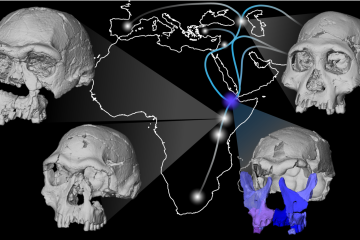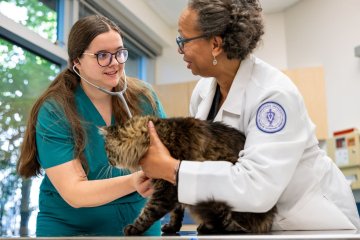Movement Therapy at Midwestern University Clinics Assists Patients with Spinal Issues
Physical Therapy Institute faculty offer advice about pain relating to the spine
- AZ - Glendale
- IL - Downers Grove
About 39 percent of adults experience back pain, according to the Centers for Disease Control and Prevention. Through Midwestern University’s Physical Therapy (PT) Institute, patients suffering from spinal issues can receive movement therapy to heal and manage pain following a disc herniation, chronic back pain, or bulging discs, as well as receive treatment for a range of spinal issues.
Mark Kargela, D.P.T., Clinical Assistant Professor at the PT Institute in Glendale, AZ, and Thomas Dillon, D.P.T., Clinical Assistant Professor at the PT Institute in Downers Grove, IL, spoke about demystifying spinal disc issues and the advantages of movement therapy as a part of the Community Health Lecture Series. “Our goal is to let someone out there hear something that helps guide them personally, or helps guide them with their family member, or gives them terminology to understand,” Dr. Dillon said.
The doctors discussed disc herniation, a disc injury typically caused by trauma such as bending and lifting, although repetitive or prolonged stresses to the back can also be factors. “The disc through either mechanical reasons or through inflammatory reasons can really irritate a nerve that’s coming off the spinal cord and so often times people will be experiencing pain radiating in their limb, whether it’s their arm or their leg,” Dr. Dillon said. Dr. Kargela shared his personal experience with disc herniation after a long drive, which caused a stabbing pain outside his hip, leg, and the outside of his foot. “I couldn’t raise up on my toes one time on that leg,” he said and then he sought a physical therapist. “In the early stages, sometimes a physical therapist can interact with you and maximize the potential to heal,” he said.
Dr. Dillon added, “It doesn’t take much sometimes. I often suggest you can be picking up a toothpick off the floor, and that could be the straw that breaks that camel’s back.” Symptoms include burning, stinging, pain radiating through the limb, the possibility of spine pain, sensation loss, numbness, tingling, and throbbing. “Even more concerning is when you start to see progressive neurological symptoms, especially rapidly progressing symptoms.” Dr. Dillon gave an example of someone experiencing radiating pain starting in the shoulder region, traveling down the arm, and rapidly developing atrophy of their thenar musculature (in hands).
The doctors emphasized that most disc issues can resolve well on their own within six weeks with proper management, such as using ice or finding proper positions of relief. Dr. Kargela said, “Mine recovered. I do have a mild sensory deficit in the outside of my foot. I’m not going to say it’s perfect, but I am back to full fitness, full activity, full doing everything without any limitations without surgery.” Dr. Kargela mentioned surgery is a necessity in some cases, but overall, these injuries can heal. Sometimes mechanical or vocational issues prolong or prevent the healing process. Dr. Dillon added, “A lot of our role is creating a good environment for that disc to recover or at least to calm down and to decrease some of those inflammatory properties that are irritating the nerve. Whether it heals or not is a larger question. But I do think it can become asymptomatic in the majority of cases.”
They also emphasized the importance of movement to the recovery process. “People that are recovered from a herniated disc have this underlying fear the disc is still herniated or still bulging,” Dr. Dillon said, “A lot of our treatment is using these movements to sensitize the whole area. It’s not even about the structure itself. Even the nervous system is involved in this and pain management, understanding that stimulus doesn’t equal pain. Don’t be afraid to move.”
They also advised people not to panic if a scan shows disc bulges. Disc bulges are more common, Dr. Kargela said. “It is a normal finding in our spine as we age to see disc bulges and disc protrusions and things like that.” Dr. Dillon also mentioned that people’s bodies change with age, and the appearance of a disc bulge does not automatically mean the patient will have an impacted life or require surgery. “It should be encouraging to people out there to see that this isn’t the answer, this isn’t the only thing we need to look at, especially because a lot of this data is coming from asymptomatic people.”
In addition to treating patients with spinal issues, the Physical Therapy Institutes in Downers Grove or Glendale offer specialty programs to assist patients with a variety of issues. Students interested in pursuing a career in physical therapy can learn more about the programs in Downers Grove or Glendale.



